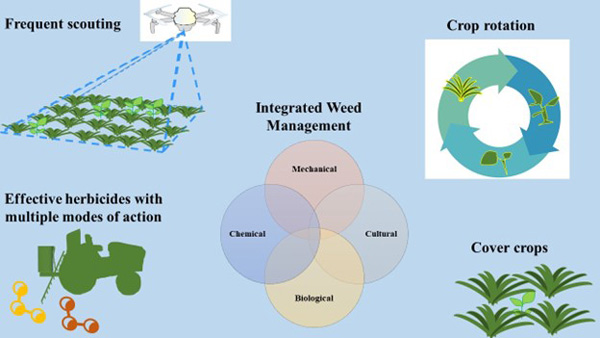Multiple herbicide-resistant weeds such as Palmer amaranth and kochia are a real threat to growers in Kansas. A Palmer amaranth population from a long-term conservation tillage research project in Kansas, uncontrolled by multiple herbicides commonly used, was confirmed to have evolved 6-way resistance by K-State researchers1. This research reported large percentages of survivors to postemergence applications of field recommended rates of:
- Group 2 (chlorsulfuron, thifensulfuron, imazethapyr, and imazamox)
- Group 4 (2,4-D)
- Group 5 (atrazine and metribuzin)
- Group 9 (glyphosate)
- Group 14 (fomesafen and lactofen)
- Group 27 (mesotrione and tembotrione) herbicides
- Tank- or pre-mixture of Group 5 and Group 27 herbicides (atrazine and mesotrione)
- Group 6 and Group 27 herbicides (bromoxynil and pyrasulfotole).
A previous eUpdate article about this population can be found here. https://eupdate.agronomy.ksu.edu/article_new/metabolism-based-herbicide-resistance-in-a-6-way-resistant-palmer-amaranth-425-5

Figure 1. Palmer amaranth escapes in a soybean field. Photo credit: Sarah Lancaster, K-State Research and Extension.
Surprisingly, these populations were not repeatedly exposed to some of the herbicides for which they showed control failures, suggesting a predominance of metabolic resistance in that population. The concern, therefore, is that metabolic resistance often confers resistance to herbicides of different chemical groups and sites of action and can extend to new herbicides.
The rapid and widespread evolution of multiple herbicide resistance in weed species due to the increased capacity to degrade (or metabolize) herbicides (metabolic resistance) threatens herbicide sustainability and global food production.
What is metabolic resistance?
Metabolic resistance, in the context of herbicide resistance, refers to the ability of weeds to increase their metabolic capacity to detoxify or break down herbicides. This means the weeds are becoming more efficient at converting herbicide molecules into non-lethal metabolites. This process is facilitated by large enzyme families in the weeds, such as cytochrome P450 and glutathione S-transferases (GSTs), which are responsible for the breakdown of herbicides.
The following link provides additional details about metabolic resistance.
Proactive actions
Effective proactive management strategies, including cultural, mechanical, biological means, and herbicide mixtures, can delay metabolic resistance evolution and enhance crop production (Figure 2).

Figure 2. Integrated weed management approach for delaying and managing metabolic resistance. Graphic adapted from Croplife.
- Cultural practices (cultivar selection, narrow row spacing, high seeding rates, and adjusting planting dates) can help reduce weed emergence and growth and improve crop competitiveness for outcompeting and suppressing weeds.
- Crop rotation is helpful for diversifying chemical weed control programs, while cover crop residues can improve weed suppression.
- At the same time, herbicide programs need to be timely and use multiple, effective modes of action against the most difficult weeds, which are more likely to evolve resistance.
- Frequent scouting is critical for your weed management program to be successful.
- Harvest weed seed control tactics (seed destructor, narrow windrow burning, and chaff lining) are helpful in preventing soil seedbank replenishment and can be crucial for managing metabolic resistance by targeting and destroying weed seeds during harvest.
Reference
1Shyam et al. (2021)
Jeremie Kouame, Weed Scientist, Agricultural Research Center – Hays
jkouame@ksu.edu
Mithila Jugulam, Weed Physiologist
mithila@ksu.edu
Sarah Lancaster, Weed Management Specialist
slancaster@ksu.edu
Tags: weed control herbicide resistance metabolic resistance